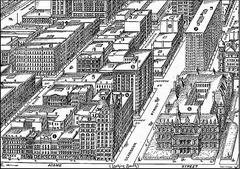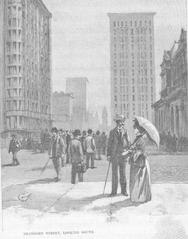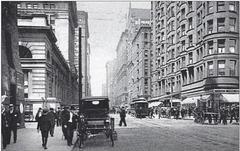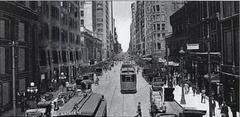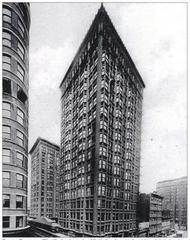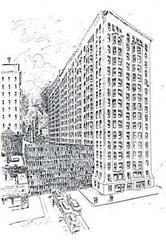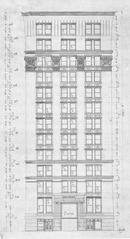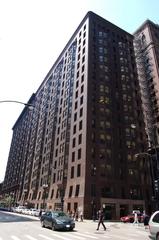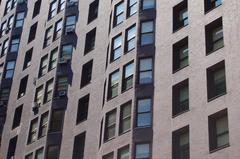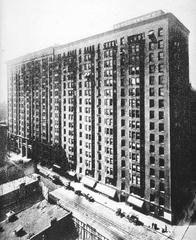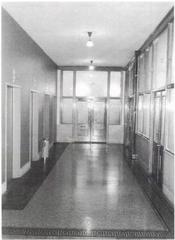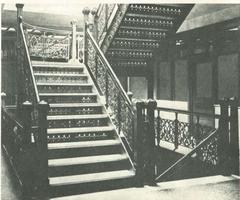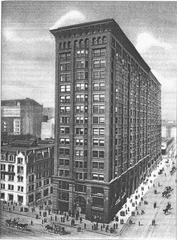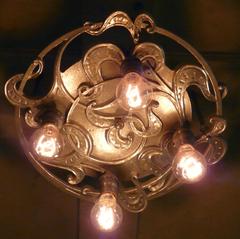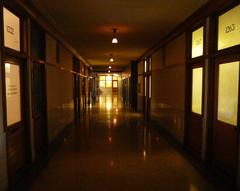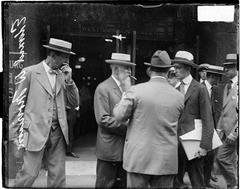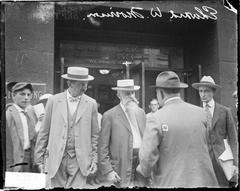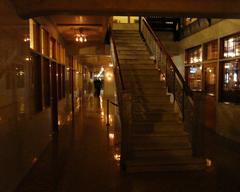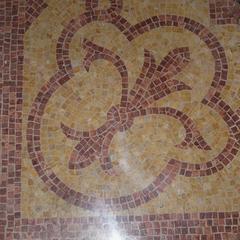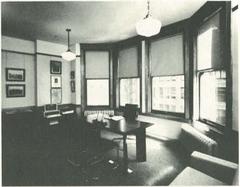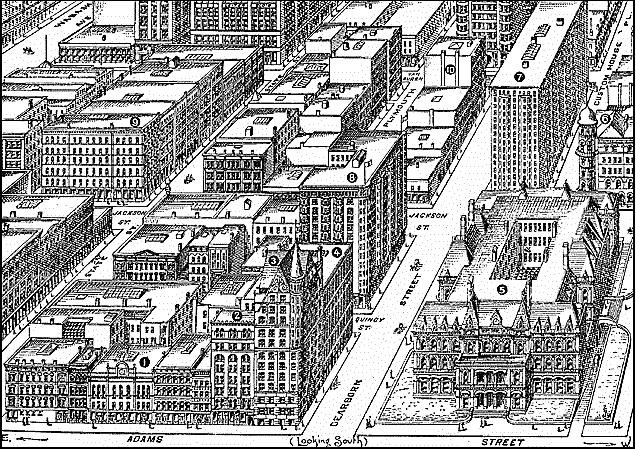
Monadnock Building Chicago: Visiting Hours, Tickets, and Historical Significance
Date: 14/06/2025
Introduction
Nestled in the heart of Chicago’s Loop, the Monadnock Building stands as a monumental symbol of the city’s architectural innovation and historical evolution. As the tallest commercial load-bearing brick building ever constructed, the Monadnock uniquely bridges the transition from traditional masonry to modern steel-frame skyscrapers. Completed in two phases between 1891 and 1893 by the renowned firms Burnham & Root and Holabird & Roche, the building’s dual structure tells the story of Chicago’s ambitious urban growth and the pioneering spirit of its era (Optima; Chicago Architecture Center).
Today, the Monadnock is both a vibrant cultural hub and a living landmark, welcoming visitors for self-guided exploration and guided tours. This guide provides comprehensive information on the building’s history, architectural significance, visiting hours, ticketing, accessibility, and tips for making the most of your visit to one of Chicago’s most celebrated historical sites.
Contents
- Introduction
- Historical Overview & Commissioning
- Architectural Vision: Burnham & Root and Holabird & Roche
- Engineering Innovations
- Cultural and Urban Impact
- Visiting Information: Hours, Tickets, and Tours
- Accessibility and Amenities
- Practical Tips for Visitors
- Nearby Attractions & Suggested Itineraries
- FAQs
- Conclusion
- Sources
Historical Overview & Commissioning
The Monadnock Building’s origins can be traced back to the post-1870s economic resurgence in Chicago. Peter and Shepherd Brooks, Boston-based real estate investors, commissioned the project as a response to the city’s growing demand for modern office space. Managed by Chicago real estate agent Owen Aldis, the building was constructed on adjacent lots in the South Loop, each section named after New England mountains and Union navy ships: Monadnock, Kearsarge, Katahdin, and Wachusett (Monadnock Building History).
Architectural Vision: Burnham & Root and Holabird & Roche
Phase One: Burnham & Root’s North Half
Construction of the north half began in 1889 under John Wellborn Root and Daniel Burnham. Completed in 1891, it became the tallest load-bearing brick building in the world at 16 stories (approximately 215 feet), with base walls up to six feet thick. Root’s radical, minimalist design features undulating bay windows and a stark, unornamented brick facade—an early embodiment of the Chicago School’s functionalist principles (EAA Architecture; Optima).
Phase Two: Holabird & Roche’s South Half
Following Root’s death in 1891, Holabird & Roche completed the south half in 1893, introducing steel-frame construction that allowed for thinner walls and more elaborate ornamentation. This section’s facade features terra cotta and decorative details that contrast with the north half’s austere brickwork, visually marking the transition from masonry to steel-frame architecture (Artchitectours Travel).
Engineering Innovations
The Monadnock Building embodies the technical evolution of skyscraper construction. The north half’s unprecedented load-bearing brickwork tapers from six feet at the base to 18 inches at the top. The building also pioneered the first portal system of wind bracing in the United States, addressing the challenges of Chicago’s strong winds. The south half’s steel frame introduced a new era of high-rise engineering, maximizing usable space and influencing future skyscraper designs (Chicago Architecture Center).
Cultural and Urban Impact
As the largest office building of its time, the Monadnock played a pivotal role in Chicago’s urban development, attracting a diverse array of tenants and fostering economic vitality in the Loop. The building’s innovative design and construction methods set a precedent for future skyscrapers and remain a reference point in architectural education. Recognized as a Chicago Landmark and National Historic Landmark, the Monadnock’s preservation and adaptive reuse have made it both a historical treasure and a vibrant, functioning part of the city (Choose Chicago; Wikipedia).
Visiting Information: Hours, Tickets, and Tours
Location: 53 W. Jackson Blvd., Chicago, IL (additional entrance at 325 S. Federal Street).
- Visiting Hours: Monday–Friday, 8:00 a.m. to 6:00 p.m. (closed weekends and major holidays; individual businesses may have extended hours).
- Tickets/Entry: Free public access to the lobby and retail arcade; no tickets required for entry. Guided tours, often offered by the Chicago Architecture Center, may require advance booking and a ticket fee.
- Guided Tours: The Monadnock is featured in several walking tours that delve into its architectural significance and history. Booking is recommended through official tour providers.
Accessibility and Amenities
- Wheelchair Accessibility: Ramps, elevators to all floors, and accessible restrooms are available. Service animals are permitted.
- Wayfinding: Clear signage, a staffed security desk in the main lobby, and elevator access make navigation straightforward.
- Dining & Retail: Bistro Monadnock offers a French bistro experience Monday–Friday, 11 a.m.–11 p.m.; other amenities include boutique shops and professional services (Monadnock Building).
Practical Tips for Visitors
- Best Times to Visit: Mid-morning or mid-afternoon on weekdays are least crowded. Evenings are ideal for dining at Bistro Monadnock.
- Transportation: Public transit via CTA trains and buses is recommended. Nearby parking garages are available but expensive (Wolters World).
- Photography: Allowed in public areas; ask permission before photographing people or private offices.
- Safety: The Loop is generally safe during business hours. Be mindful of weather-related hazards in winter.
Nearby Attractions & Suggested Itineraries
The Monadnock is within walking distance of:
- The Art Institute of Chicago
- Millennium Park and Cloud Gate (“The Bean”)
- Willis (Sears) Tower Skydeck
- The Rookery Building and other Loop landmarks
Architecture enthusiasts can enhance their experience with a Chicago Architecture Foundation river cruise or walking tours (The Savvy Globetrotter).
Frequently Asked Questions (FAQ)
Q: What are the Monadnock Building visiting hours?
A: Monday–Friday, 8:00 a.m.–6:00 p.m.; businesses may have longer hours.
Q: Is there an admission fee or ticket required?
A: No, entry to public areas is free. Guided tours may require paid tickets.
Q: Are guided tours available?
A: Yes, through the Chicago Architecture Center and other providers.
Q: Is the building wheelchair accessible?
A: Yes, with accessible entrances, elevators, and restrooms.
Q: Can I take photos inside the Monadnock Building?
A: Yes, in public and retail areas.
Q: What other landmarks are nearby?
A: Millennium Park, Art Institute of Chicago, and the Rookery Building.
Conclusion
The Monadnock Building stands as a living testament to Chicago’s architectural ingenuity and urban vitality. Its dual construction phases—one rooted in 19th-century masonry, the other pioneering steel-frame design—make it a must-see for anyone interested in architecture, history, or the dynamic spirit of Chicago. Free to enter and conveniently located in the Loop, the Monadnock offers rich historical context, fascinating design, and vibrant street-level culture.
To enhance your visit, consider downloading the Audiala app for curated guides, maps, and up-to-date information on Chicago’s architectural gems. For ongoing updates, tour bookings, and more, follow official channels and explore related articles on Chicago’s architectural legacy.
Sources
- This guide draws on the following sources for accuracy and further reference:
- Optima: Chicago Skyscraper History – The Monadnock Building
- Monadnock Building History
- Chicago Architecture Center: Monadnock Building
- Artchitectours Travel: Architecture Trip to Chicago
- Choose Chicago: Monadnock Building
- ChicagoDetours: Monadnock Building
- Bistro Monadnock at Eater Chicago
- The Savvy Globetrotter: Things to Do in Chicago
- Wolters World: 25 Things Tourists Should Never Do in Chicago
- Monadnock Building – The Building
